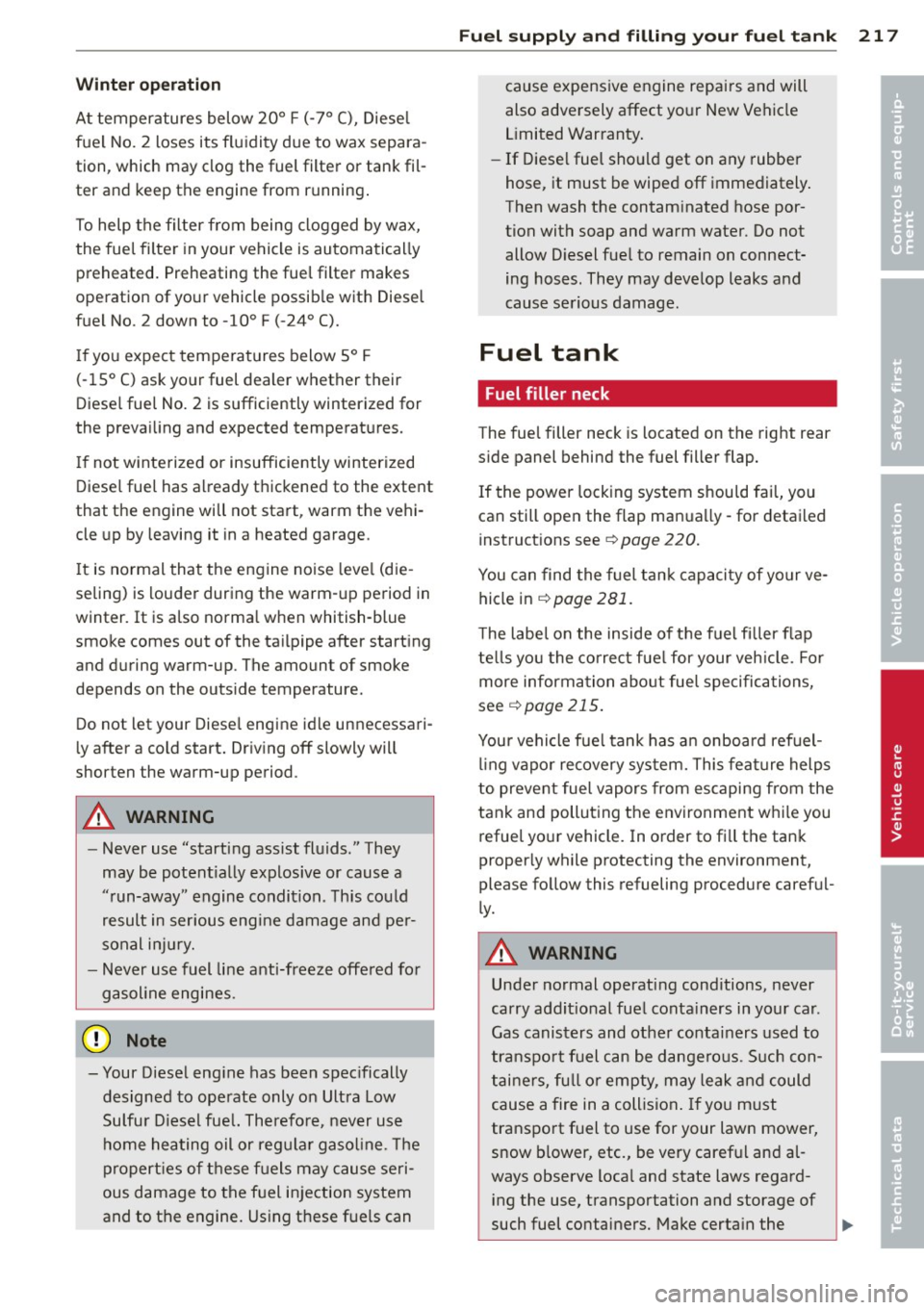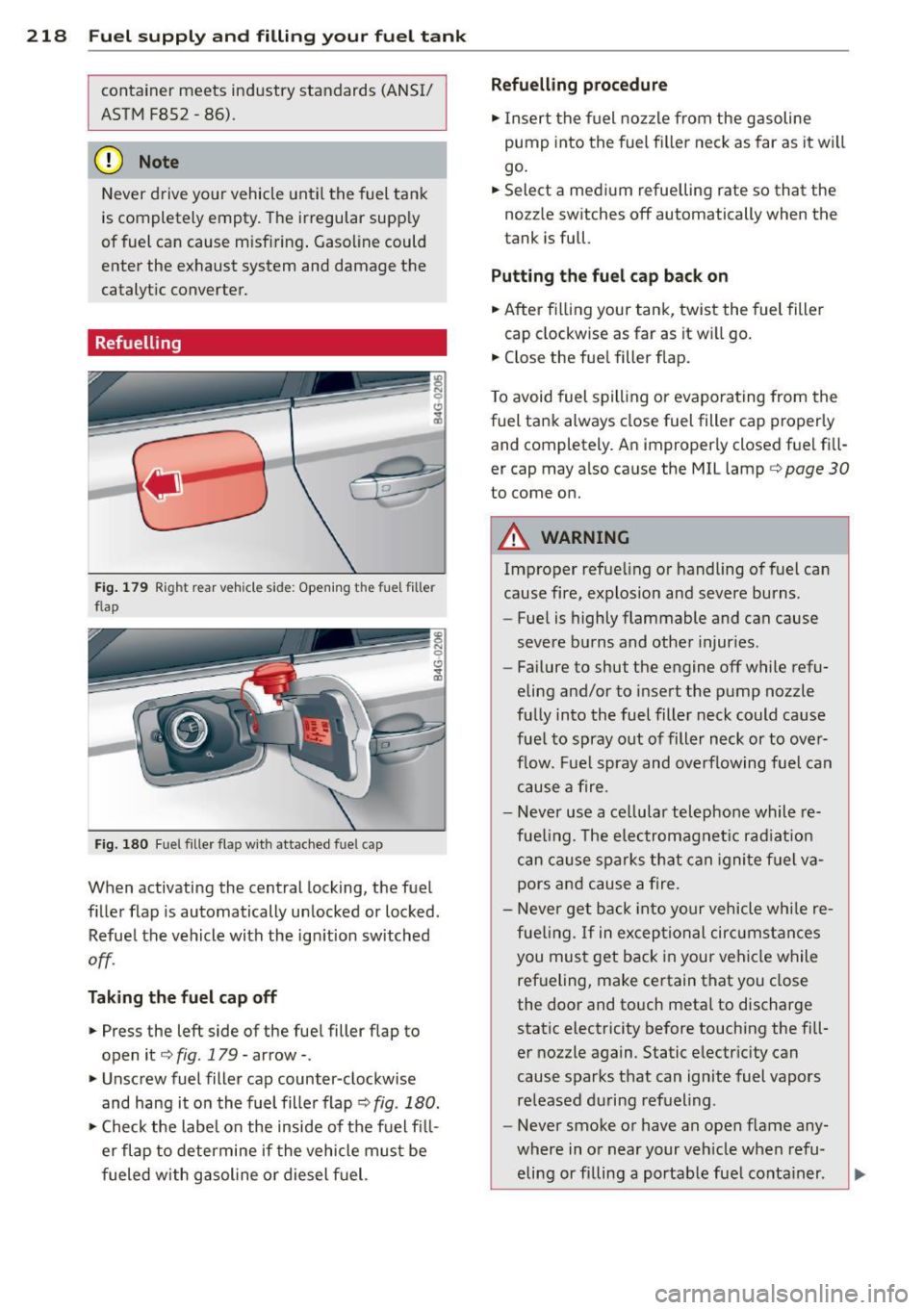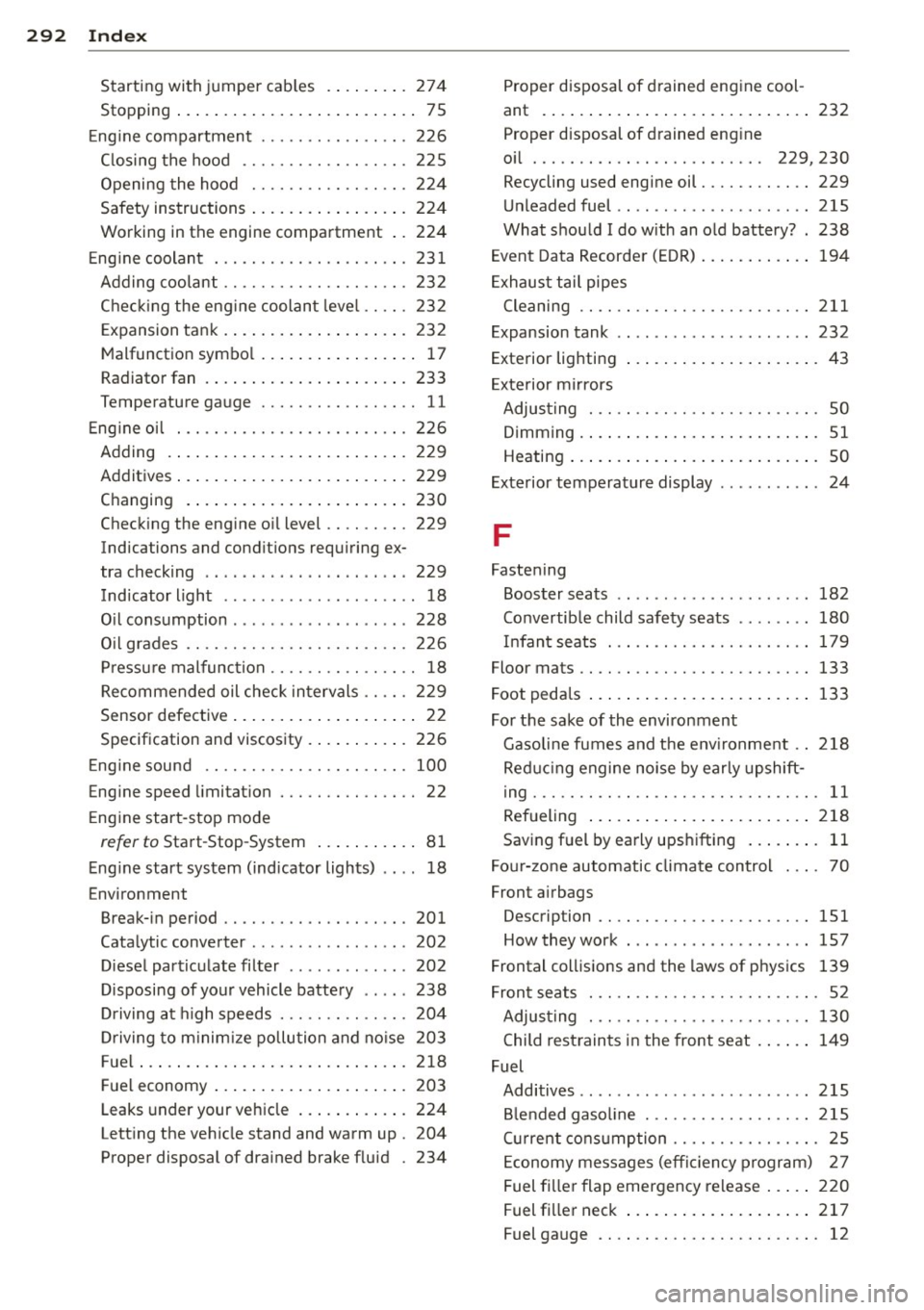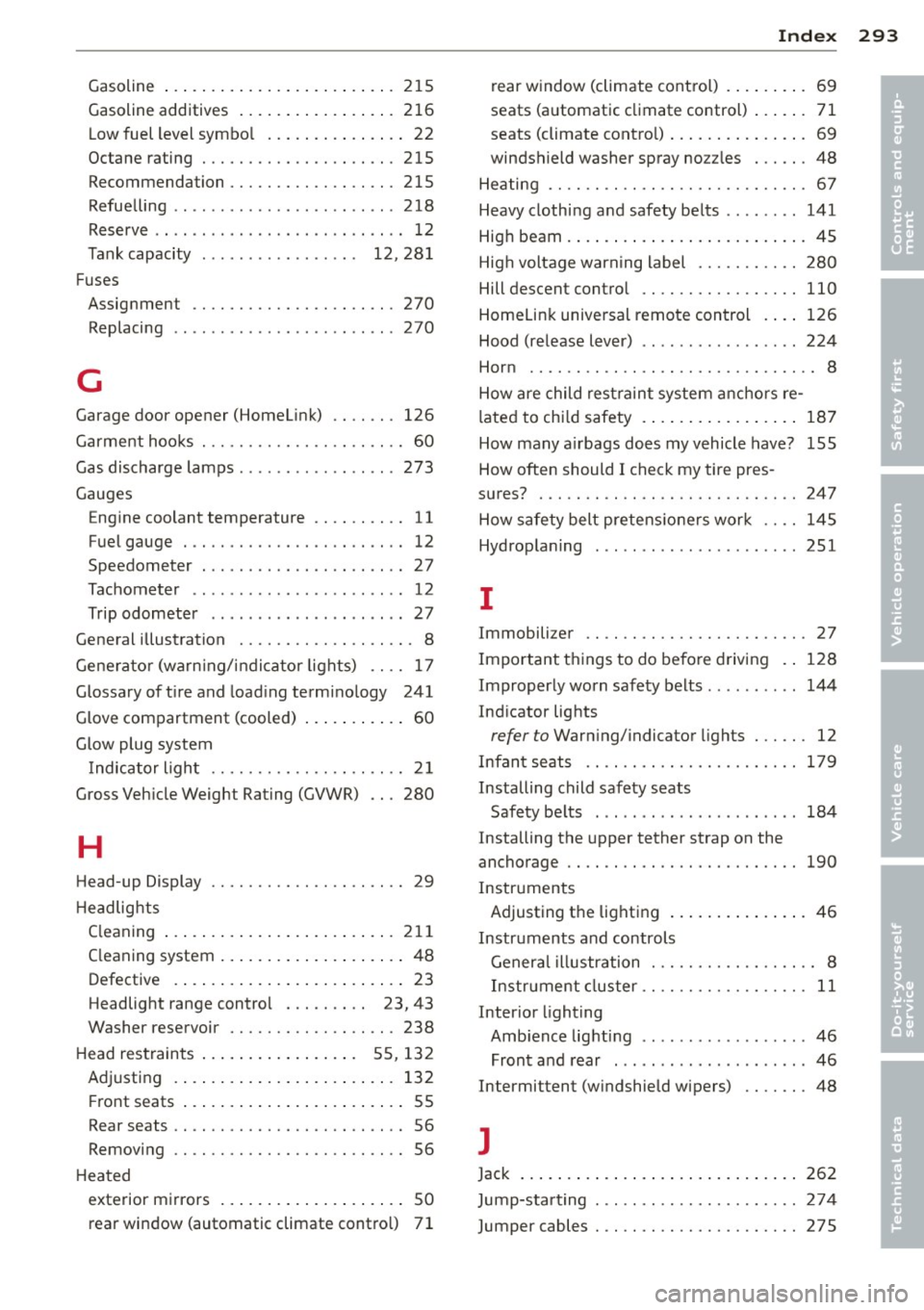open gas tank AUDI S6 2014 Owners Manual
[x] Cancel search | Manufacturer: AUDI, Model Year: 2014, Model line: S6, Model: AUDI S6 2014Pages: 304, PDF Size: 76.32 MB
Page 219 of 304

Winter operation
At temperatures below 20° F (-7° C), Diesel
fuel No.
2 loses its fluidity due to wax separa
tion, which may clog the fuel filter or tank fil
ter and keep the engine from running .
To help the filter from being clogged by wax,
the fuel filter in your vehicle is automatically
preheated. Preheating the fuel filter makes
operation of your vehicle possible with Diesel
fuel No . 2 down to -10° F (-24° C).
If you expect temperatures below
5° F
(-15° C)
ask your fuel dealer whether their
Diese l fuel No.
2 is sufficiently winterized for
the prevailing and expected temperatures.
If not winterized or insufficiently winterized
Diesel fuel has already thickened to the extent
that the engine will not start, warm the vehi
cle up by leaving it in a heated garage.
It is normal that the engine noise leve l (die
seling) is louder during the warm-up period in
winter.
It is also norma l when whitish-blue
smoke comes out of the tailpipe after start ing
and during warm-up . The amount of smoke
depends on the outs ide temperature.
Do not let your Diese l engine id le unnecessari
ly after a cold start. Driving off slowly will
shorten the warm-up period .
A WARNING
-Never use "starting assist fluids." They
may be potent ially explosive or cause a
"run-away" engine condition. This could
result in serious engine damage and per
sonal injury.
- Never use fuel line anti-freeze offered for
gasoline engines .
0 Note
- Your Diesel engine has been specifically
designed to operate only on Ultra Low
Sulfur Diesel fuel. Therefore, never use
home heating oil or regular gasol ine. Th e
properties of these fuels may cause seri
ous damage to the fuel injection system
and to the engine. Using these fuels can
-
Fuel supply and filling your fuel tank 217
cause expensive engine repai rs and will
also adversely affect your New Vehicle
Limited Warranty.
- If Diesel fuel should get on any rubber
hose, it must be wiped off immediately.
Then wash the contaminated hose por
tion with soap and warm water. Do not
allow Diesel fuel to remain on connect
ing hoses . They may develop leaks and
cause serious damage.
Fuel tank
Fuel filler neck
The fuel filler neck is located on the right rear
side panel behind the fuel filler flap.
If the power locking system should fail, you
can still open the flap manually -for detailed
instructions see
¢ page 220.
You can find the fuel tank capacity of your ve
hicle in
¢ page 281.
T he labe l on the inside of the fuel fi ller flap
tells you the correct fuel for your vehicle. For
more information about fuel specifications,
see
¢ page 215.
Your vehicle fuel tank has an on board refuel
ling vapor recovery system. This feature helps
to prevent fuel vapors from escaping from the
tank and polluting the environment while you refue l your vehicle. In order to fi ll the tank
properly while protecting the environment,
please follow this refueling procedure careful
ly.
A WARNING
Under normal operating conditions, never
carry addit ional fuel conta iners in your car .
Gas canisters and other containers used to
transport fuel can be dangerous. Such con
tainers, full or empty, may leak and could
cause a fire in a collision. If you must
transport fuel to use for your lawn mower,
snow b lower, etc., be very careful and al
ways observe loca l and state laws regard
ing the use, transportation and storage of
such fuel containers. Make certain the
~
•
•
Page 220 of 304

218 Fuel supply and filling your fuel tank
container meets industry standards (ANSI/
ASTM F852 -86) .
(D Note
Never drive your vehicle until the fuel tank
is completely empty. The irregular supply
of fuel can cause misfiring . Gasoline could
enter the exhaust system and damage the
catalytic converter.
Refuelling
Fig. 179 R ig ht rear v ehicl e side: Openin g th e fu el fille r
fl ap
Fig. 180 Fu el f iller flap with attached f uel cap
When activating the central locking, the fuel
filler flap is automatically unlocked or locked .
Refuel the vehicle with the ign ition switched
off .
Taking the fuel cap off
,. Press the left side of the fuel filler flap to
open it
c:> fig. 179 -arrow -.
,. Unscrew fuel filler cap counter -clockwise
and hang it on the fuel filler flap
c:> fig. 180.
,. Check the label on the inside of the fuel fill
er flap to determine if the vehicle must be
fueled with gasoline or diesel fuel.
Refuelling procedure
,. Insert the fuel nozzle from the gasoline
pump into the fuel filler neck as far as it will
go .
,. Select a med ium r efuelling rate so that the
no zzle switches off automatically when the
tank is full.
Putting the fuel cap back on
,. After filling your tank, twist the fuel filler
cap clockwise as far as it w ill go.
,. Close the fue l filler flap.
T o avoid fuel spilling or evaporating from the
fuel tank always close fuel filler cap properly
and completely. An improperly closed fuel fill
er cap may also cause the MIL lamp
c:> page 30
to come on.
A WARNING
Improper refue ling or handling of fuel can
cause fire, explosion and severe burns.
- Fuel is highly flammable and can cause
severe burns and other injur ies .
- Failure to shut the engine off while refu
eling and/or to insert the pump nozzle
fully into the fuel filler neck could cause
fuel to spray out of filler neck or to over
flow. Fuel spray and overflowing fuel can
cause a fire.
- Never use a cellular telephone while re
fue ling. The electromagnet ic rad iat ion
can cause sparks that can ignite fuel va
pors and cause a fire.
- Never get back into your vehicle whi le re
fueling.
If in exceptional circumstances
you must get back in your vehicle while
refueling, make certain that you close
the door and touch metal to discharge
static electricity before touching the fill
er nozzle again. Static electricity can
cause sparks that can ignite fuel vapors
released during refueling .
- Never smoke or have an open flame any
where in or near your veh icle when refu-
eling or filling a portable fuel conta iner . ..,
Page 294 of 304

292 Index
Starting with j umper cab les . ....... . 274
Stopping . . . . . . . . . . . . . . . . . . . . . . . . . . 7 5
E ng ine compartment ....... .... .... . 226
C lo sing the hood ....... .. .. .. .. .. . 225
Opening the hood ........ .. .. .... . 224
Safety instructions ..... ... .. .. .... . 224
Working in the engine compartment .. 224
E ng ine coolant .......... .. .. .. .. .. . 23 1
Adding co ol ant ........... .. .. .... . 23 2
Che ckin g the eng ine coolan t leve l .. ... 232
E xpansion tan k ... ..... ... .. .. .... . 23 2
M alfunctio n symbo l . . . . . . . . . . . . . . . . . 17
Radiato r fan . .. .. ..... ... .. .. .... . 233
Temperature ga uge ....... .. .. .. .. . . 11
E ng ine oi l ..... ........... .... .... . 226
Adding .... ... . ...... ... .. .. .... . 229
Addit ives ... ... .. ..... ... .. .. .... . 229
C hanging . .... . ...... ... .. .. .... . 230
Check ing the eng ine o il level .. .. .... . 229
Indications and cond it ions requ iring ex-
tra check ing .. ... .... .... .. .. .. .. . 229
Ind icator light . . . . . . . . . . . . . . . . . . . . . 18
O il consumption ........... ... .. .. . 228
O il g rades .. .. . .......... .. .. .... . 226
Pr ess ure mal function ...... .. .. .. .. . . 18
Recommended oil check in tervals .... . 229
Sensor defective . . . . . . . . . . . . . . . . . . . . 22
Specification and viscos ity . ... .. .. .. . 226
E ng ine sound ............. .. .. .... . 100
Eng ine speed limitat ion ..... .. .. .... .. 22
E ng ine start -stop mode
refer to Start -Stop -System ... ... ... .. 81
E ng ine start system (ind icator lights) .... 18
Environment Break- in period ........... .. .. .. .. . 201
Cata lytic conve rter .. ...... .. .. .. .. . 202
Diese l partic ulate fil ter ..... ... .. ... 202
Di sposing of you r vehicle batte ry .. .. . 238
Dr iving a t high speeds ... .. .. .. .. .. . 20 4
D riving to m inim ize pollu tion and no ise 203
Fu el . .... .. ... ... .... ... .. .. .... . 2 18
Fu el economy .. . ...... ... .. .. .... . 203
L eaks under your veh icle ... .. .. .. .. . 224
Lett ing the vehicle stand and warm up . 204
Proper disposal of dra ined brake f luid . 234 Proper disposal of d
rained eng ine cool -
ant . ... .. .... .. .. ... ..... ... .. .. 232
Proper d isposal of d rained eng ine
o il . . . . . . . . . . . . . . . . . . . . . . . . . 229, 230
Recycling used engine oil ........ .... 229
U nleaded fuel .. .. ................ . 215
What s hou ld I do w ith an o ld battery? . 238
Event Data Recorde r (EDR) ..... ... .. .. 194
E xhaus t tai l pipes
C leaning .. .. .. . .............. .. .. 211
Expansion tank .. .. .......... ...... . 232
Exterior lighting ... .. ... ..... ... .. .. . 43
E xte rior mi rrors
Adjus ting . .... .. .. ........... .... . 50
D imming . ..... .. .. ... ..... ... .. .. . 51
Heating . . . . . . . . . . . . . . . . . . . . . . . . . . . 50
E xterior tempera ture display ........... 24
F
Fastening
Booster seats . . . . . . . . . . . . . . . . . . . . . 182
Co nvertib le child safety seats ........ 180
I n fan t seats ... .. ............. .... 179
Floor mats .. .... .. ............. .... 133
F oot peda ls ..... .. .. ... ..... ... .. .. 133
Fo r the sake of the environment
Gasoli ne fumes and the env ironme nt .. 218
Red ucing engine noise by early upshift -
i ng ....... .. .. .. .. ............... . 11
Ref ueling ..... .. ... .. ..... .... . .. 218
Saving f uel by early ups hifting ... .. .. . 11
Fo ur- zone automatic climate control . .. . 70
Front a irbags
Descrip tion .... ... ................ 151
How they work . .. .......... ...... . 157
Frontal col lisions and the laws of p hysics 139
Front seats . . . . . . . . . . . . . . . . . . . . . . . . . 52
Adjus ting . .. .. .. ............. .. .. 130
C hild rest rain ts in the front seat . ... .. 149
Fuel Additives ...... .. ..... ........... . 215
B len ded gaso line .............. .... 215
Cur rent co nsumption ........... .... . 25
E conomy messages (e fficiency p rogram) 2 7
Fuel fi lle r flap emergency release ... .. 220
Fuel fi lle r neck ... .. .... .... ... .. .. 217
Fuel gauge . . . . . . . . . . . . . . . . . . . . . . . . 12
Page 295 of 304

Gasoline ... .. .... .... ... .. .. .. ... 215
Gasoline additives ..... ... .. .. .. .. . 2 16
L ow fuel level symbo l .. ... .. .. .. .. .. 22
Octane rating ............ .... .. ... 215
Recommendation ......... .. .. .. .. . 215
Refue lling .. ................ ... ... 218
Reserve . ... ... .. .. ...... .. .. .. .. .. 12
Tank capacity . . . . . . . . . . . . . . . . . 12, 28 1
Fuses Assig nment ............. .... .. ... 270
Replacing ............ ...... .... .. 270
G
Garage door opener (Homel ink) .. .. .. . 126
Garment hoo ks . . . . . . . . . . . . . . . . . . . . . . 60
Gas discharge lamps ........... .... .. 273
Gauges Engine coolant temperature .. .. .. .. .. 11
F uel gauge . .. .. ......... .. .. .. .... 12
Speedometer ... .... ... .. .. .. .. .. .. 27
Tac hometer .. ........ ...... ... ... . 12
Trip odometer ........ .... ... ... ... 27
Gene ral illustration . . . . . . . . . . . . . . . . . . . 8
G ene ra to r (wa rn ing/ indic ator lights) .. .. 17
Glossary of t ire and load ing termi no logy 241
Glove com partment (cooled) . . . . . . . . . . . 60
G low plug system
Indicator ligh t . . . . . . . . . . . . . . . . . . . . . 21
Gross Veh icle Weight Rating (GVWR) .. . 280
H
Head -up Display . . . . . . . . . . . . . . . . . . . . . 29
H eadlights
C leaning ... .. ... ..... ... .. .. .. ... 211
C leaning system ... .... ... .. .. .. .. .. 48
Defective . ... .... .... ... .. .. .. .... 23
Headlig ht range contro l . . . . . . . . . 23, 43
Washer reservoir ......... .. .. .. .. . 238
H ead res train ts . . . . . . . . . . . . . . . . . 5 5, 13 2
A dju sting . ... .. ... . .. ... .. .. .. ... 132
Fr ont seats . . . . . . . . . . . . . . . . . . . . . . . . 55
Rear seats .. .. .. ......... .. .. .. .... 56
Removing .. ............. .... .. .. .. 56
H ea ted
exte rior m irrors ... .... ... .. .. .. .. .. 50
rear window (automatic climate cont ro l) 7 1
Index 293
rear w indow (climate cont rol) . ... .. .. . 69
seats (a utomatic climate control) ... .. . 71
seats (climate cont ro l) . . . . . . . . . . . . . . . 69
windshield washer spray no zzles ... .. .
48
He ating .... .. .. .. ................. . 67
Heavy clothi ng a nd safety be lts ... .... .
141
High beam . ... .. .... . ... ...... ... .. . 45
Hig h voltage warn ing label ....... .. .. 280
Hill descent contro l .... ............. 110
Homelin k unive rsal remote con trol . ... 126
Hood (re lease lever) .. .............. . 224
Hor n .......... .. .... ............. .. 8
How are child rest raint syste m anchors re-
lated to ch ild safety . .. .. .. ..... ... .. 18 7
How many a irbags does my vehicle have? 155
How ofte n should I check my tire pres -
s u res? ..... .. .. .. .. .. ........... .. 247
H ow safety belt pretens io ne rs wor k . . . . 1 45
Hydrop la ning ..... .. ..... .......... 251
I
Immobilize r . . . . . . . . . . . . . . . . . . . . . . . . 27
Impo rtant t hings to do be fore driving . . 128
Improperly worn safe ty belts .. ... ... .. 144
Ind icator lights
refer to Warn ing/ indicator lights . .. .. . 12
Infan t seats . . . . . . . . . . . . . . . . . . . . . . . 17 9
Installing child safety seats Safety be lts . . . . . . . . . . . . . . . . . . . . . . 184
Installing the upper tether strap on the
anchorage .... .. ...... ............. 190
Instruments Adjusting the light ing .. ..... ... .. .. . 46
Instrum ents and controls
Genera l illustration . . . . . . . . . . . . . . . . . . 8
Instr ument cluster . . . . . . . . . . . . . . . . . .
11
Interior lighting
Amb ience lighti ng .. .. .. ...... .... .. 46
Front and rear .... ................. 46
Intermittent (w indshie ld wipers) ...... . 48
J
Jack 262
Jump-starting . .. ................... 274
Jumper cables . .. ................... 275
•
•